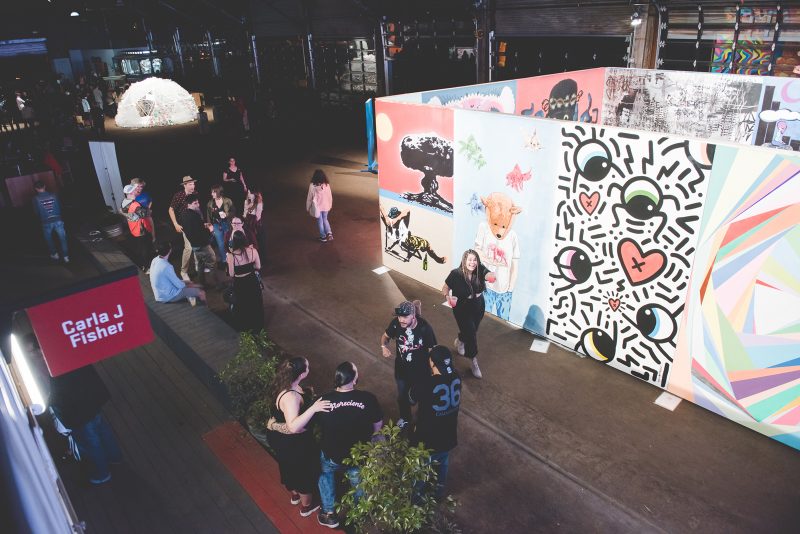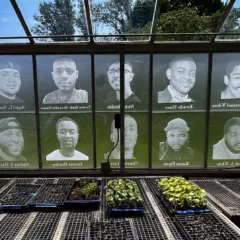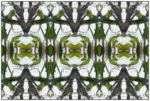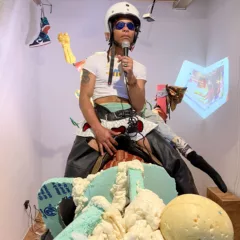
Reflection: Plastic Fantastic at Tiny Room for Elephants Festival 2019
by Diedra Krieger
Have you ever been asked how many hours you’ve put into a project? And have you ever successfully logged every hour put in?
For Tiny Rooms for Elephants Festival 2019 (TRFEF19), I documented each action performed for Plastic Fantastic (PF) art project. Participants included two schools and 14 volunteers.
Reflecting later, I had to pause and think about what drives me (and the artists and producers of TRFEF19) to do this endurance art work, investing time and resources, deeply committing to the realization of just 1% of the imagination. Could it be recognition? A labor of love? Creating culture? Building community?
TRFEF19 was held at Cherry Street Pier, April 19-21, 2019, receiving 13,000 visitors. The team led by Yaya Horne and Dame Ward built a 38 panel gallery space and artists completed 10’x6’ or 10’x12’ panels or did installations, with a festival line up of 20 musicians and DJs. There were many sponsors, donated services and supplies — Champion never looked so good as when Yaya and Dame rocked it. Bringing all of these moving parts together, underpinned by a strong network of dedicated artists, musicians and designers, made it a truly immersive cultural experience.
Daunted at the idea of collecting 4000 post-consumer water bottles for PF’s geodesic dome after 4 years, I reached out to my network to see if I could find someone up for leading the collection. Ashley Viechweg-Lewis a middle-school teacher from AMY at James Martin School who I met through work would run a school-wide bottle collecting contest in March at her school. Students were surprisingly into it! Coincidentally, Beth Gordon a newly certified high school art teacher recently expressed interest in PF again too (the dome under her lead was at her school in 2014). Excited about an idea to take PF in a new direction towards robot origami, Beth and I met with Professor Cynthia Sung and PhD Student Wei-Hsi Chen to develop robogami inspired methods for cutting and folding the bottles. In a short time, the teachers made key tenets of PF a reality. My 3rd floor apartment became the Play Factory, transformed by white plastic covering the floor, work stations and clamp lights. At this pre-production site for PF, old and new friends jumped on board too to make it happen. PF lives!
But this time I found a new limit, the fear of a car accident. When my husband and I went to pick up the 4263 water bottles from Ashley’s school — miraculously, enough for the project! — students joyfully loaded them onto a borrowed pick-up truck, which quickly filled up double the height of its bed walls! And we filled our car with bags too, but when we entered 95 S, we had to pullover. A state trooper diverted traffic, but the shoddy transportation plan left me anxious and terrified of cars as my husband alone fixed the tarp holding the bags on the truck. Reflecting later, it’s amazing the extremes and extra distance often the life partners of artists will go for them, but this kind of risk was untenable.
Could it be a calling, a purpose, a labor of love that pushes us into these intense, just-in-time spaces of making, deep in the materials — linked to them, working til our hands hurt, until we can’t keep our eyes open? Going and going day after day with the deadline looming in front of us, perfectly content to be in this space as the work grows before your eyes, hoping that maybe it will be what was imagined? During TREF19 install, I found like-minded artists, going strong for their artistic intention. My nearest neighbors were welcoming and we talked art. In process, I felt our shared experience – engaged, focused, exploring, thinking, creating. Oh, to be in the space of collective art-making! This writing gets close to that feeling, losing myself and having the work carry me – collaborate, collect, construct, play — it touches it, seeing it clearly again in reflection.
Conrad Benner, photographer, curator and founder of Streets Dept, emphasized TRFEF19’s DIY nature and highlighted artwork through images in a Sneak Preview, writing “Tiny Room for Elephants [was] hands down one of the best art things to happen in Philly in the last number of years.” Seeing PF included was rewarding but media coverage is not just about recognition. Rather, it is critical for dissemination of the work and creating a better informed audience about the work. From Benner’s insights I gained a sense of how TRFEF19 functioned in Philadelphia’s art world and see how they contribute to this community doing cultural production.
Beth brought her art students from Kensington High School on a field trip to TRFEF19 to add their panels created in class to PF’s dome and complete the remaining 15 panels. Jason Bachman from TRFEF took them on a tour and the students were inspired by the art that they could relate to. One student who loved pink was just smitten with Ali M Williams’s wall covered in layers of hot pink clouds. The amazing students became part of the PF extended community of family, friends, neighbors and colleagues, rising to both the art challenges in the classroom and on-site, working collaboratively, being part of something larger than ourselves.
Speaking to my 4 year old on the way to school about what he remembered from TRFEF, he told me he misses the dome and wants to do it again. That was amazing to hear as I try to balance a full-time job, art, family, friends, self-care. My hands age before my eyes as I type, reminded it’s worth the struggle to make small increments of time for art. I feel the undeniable awe in my heart from PF and those who helped make it happen — and from PF being a visitor of TRFEF19 — and begin to understand what drives this art practice. How better to build a community than through the shared experience to create culture together?
Bio
Diedra Krieger is an intermedia artist, curator and lab coordinator exploring the intersection of robotics, immersive environments and performance. Her ongoing project Plastic Fantastic has been exhibited across the country, from the Anchorage Museum to Governor’s Island to the banks of the Schuylkill River. In 2018, posters of her work were published with Science Through Narrative Symposium, Society for Integrative and Comparative Biology SICB and WIC. Diedra has an MFA from VCFA and an MA from Monash University.









